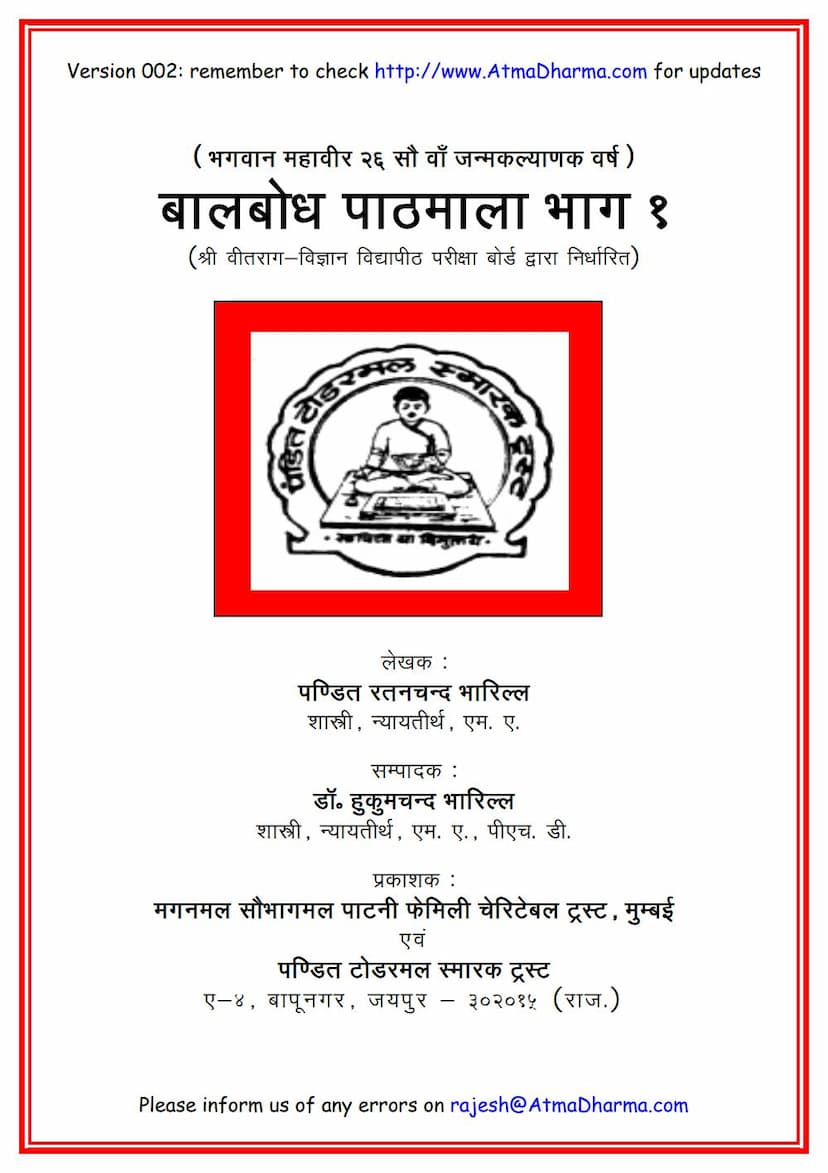Balbodh Pathmala 1
Added to library: September 1, 2025

Summary
Here's a comprehensive summary of the Jain text "Balbodh Pathmala - Part 1":
Book Title: Balbodh Pathmala - Part 1 Author: Pandit Ratanchand Bharilla Shastri, Nyaytirtha, M.A. Publisher: Todarmal Granthamala Jaipur (also mentions donation from Maganmal Saubhagmal Patni Family Charitable Trust, Mumbai) Catalog Link: https://jainqq.org/explore/008220/1
Overall Purpose:
"Balbodh Pathmala - Part 1" is a foundational text designed for the religious education of children. It aims to introduce young Jain learners to essential concepts, practices, and figures within Jainism in a simple and accessible manner. The book is structured into lessons (Path) that cover core tenets and ethical guidelines.
Key Concepts and Lessons Covered:
The book is organized into several lessons, each focusing on a specific aspect of Jainism:
-
Lesson 1: Namokar Mantra (णमोकार मंत्र)
- Content: This lesson focuses on the paramount Jain mantra, the Namokar Mantra, which is an invocation of respect to the five supreme beings (Panj Parmeshthi) in Jainism: Arihants, Siddhas, Acharyas, Upadhyayas, and Sadhus.
- Significance: It explains that the mantra is a destroyer of all sins and the foremost of all auspicious things. It also highlights that devotion to these five supreme beings leads to true happiness.
- Learning Objectives: Students are expected to recite the mantra correctly, understand who is being saluted, the benefits of remembering the mantra, and the names of the five supreme beings.
-
Lesson 2: Four Mangals (चार मंगल)
- Content: This lesson introduces the "Four Mangals" – Arihants, Siddhas, Sadhus, and the Vitarag Dharma (the path of non-attachment taught by the omniscient ones).
- Significance: It defines "Mangal" (auspicious) as that which destroys sinful tendencies (like attachment, aversion) and brings true happiness. It also explains the concepts of "Uttam" (supreme) and "Sharan" (refuge).
- Learning Objectives: Students are taught to understand the meaning of these terms and to take refuge in the teachings of the Panj Parmeshthi.
-
Lesson 3: Tirthankar Bhagwan (तीर्थंकर भगवान)
- Content: This lesson clarifies the concept of a Tirthankar. It explains that while the 24 Tirthankars are divine, any Vitaragi (free from attachment and aversion) and Sarvajna (omniscient) being is considered a Bhagwan (God).
- Significance: It defines Tirthankars as those who preach the path to liberation (Moksha) and possess special divine powers. It lists all 24 Tirthankars, providing a mnemonic verse for memorization.
- Learning Objectives: Students learn to differentiate between a Tirthankar and a Bhagwan, know the number and names of the Tirthankars, and understand that following their teachings can lead to becoming divine.
-
Lesson 4: Devdarshan (देवदर्शन - Worship of the Divine)
- Content: This lesson outlines the proper etiquette and procedure for visiting a Jain temple (Mandirji) to have Darshan (sight) of the divine idols.
- Significance: It emphasizes key aspects like removing leather items, removing shoes before entering, washing hands and feet, chanting mantras like Namokar and Cattari Mangalam, offering obeisance (Ashtang Namaskar), circumambulation (Pradakshina), and meditating on the divine. It also stresses the importance of understanding the teachings and reflecting on them.
- Learning Objectives: Students are taught the correct way to approach temple worship for spiritual benefit and inner peace.
-
Lesson 5: Jiv-Ajiv (जीव-अजीव - Soul and Non-soul)
- Content: This is a fundamental lesson on the Jain concept of the two main categories of existence: Jiv (soul/living being) and Ajiv (non-soul/non-living matter).
- Significance: It defines Jiv as that which knows and experiences (the conscious entity, the soul/Atma) and Ajiv as that which does not know or experience. It clarifies that while the body, senses, and organs are Ajiv, the soul is the true knower and experiencer.
- Learning Objectives: Students learn to identify what is Jiv and what is Ajiv, understanding that the self (Atma) is Jiv, and realizing this distinction is crucial for spiritual progress and happiness.
-
Lesson 6: Dinacharya (दिनचर्या - Daily Routine)
- Content: This lesson guides children on establishing a disciplined daily routine.
- Significance: It emphasizes punctuality, hygiene (bathing, brushing teeth), performing religious duties (chanting Namokar mantra, temple visits), studying, eating at appropriate times (avoiding night meals), and meditating on the soul. It highlights the importance of both physical and mental purity.
- Learning Objectives: Students are encouraged to adopt a structured daily routine that incorporates spiritual practices for overall well-being and character development.
-
Lesson 7: Bhagwan Adinath (भगवान आदिनाथ)
- Content: This lesson provides an introduction to the first Tirthankar, Lord Adinath (also known as Rishabhdev).
- Significance: It recounts his life story, from his birth as a prince to his renunciation of the world, attainment of omniscience, and eventual liberation. It mentions key events like the dance of Nilanjana that led to his detachment, his first disciple Bharat, and the origin of Akshay Tritiya.
- Learning Objectives: Students learn about the life and teachings of the first Tirthankar, understanding that divinity is attained through spiritual practice and detachment.
-
Lesson 8: Mera Dham (मेरा धाम - My Abode)
- Content: This lesson is a devotional verse or song that describes the true abode of the soul.
- Significance: It portrays the soul's true nature as pure consciousness ("Shuddhatma") whose function is "knowing" ("matra jannana mera kaam"). The "abode" is described as a place of complete rest, free from hunger, thirst, illness, and suffering. It emphasizes self-realization, overcoming attachment and aversion, and experiencing eternal bliss.
- Learning Objectives: This lesson instills a sense of the soul's inherent purity and its ultimate goal of liberation and eternal peace.
Publisher and Edition Information:
The book has seen multiple editions and translations, indicating its popularity and importance in Jain education. The copyright information and version updates suggest an effort to maintain accuracy in the electronic distribution.
In essence, "Balbodh Pathmala - Part 1" serves as a comprehensive introductory guide for young Jains, covering essential prayers, foundational philosophical concepts (Jiv-Ajiv), the lives of important spiritual figures, and guidance on daily conduct and temple worship, all aimed at fostering spiritual understanding and practice from an early age.